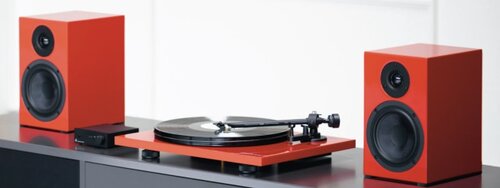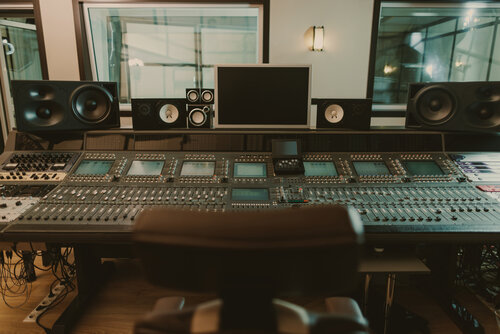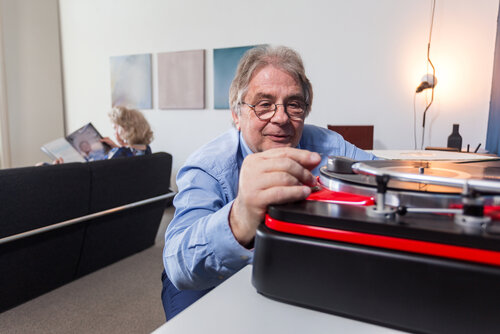The High-Fidelity Scene

Recording technology revolutionized how music is produced, played, and experienced. From the perspective of experiencing it, to the old model of attending a live concert was added the option of listening to a recorded performance. In this new model, the listener’s role and situation were profoundly transformed; with recordings, listening has been privatized. The listener is free to choose how to play the music, where and when to play it, and under what circumstances. No longer constrained by the conventions of a live concert, the listener can express their own personality in the choices made in how music is listened to.

While this new, more active role of the listener is real, at first glance it might seem an exaggeration to equate it to a form of artistic work. However, in the case of certain groups, notably the high-fidelity scene, where one subjectively seeks an ideal of how music should sound, the final arbiter of what that sound will be is none other than the listener. We may even be able to draw a parallel between the production and reproduction stages. Just as the record producer is the one who oversees the recording process, the listener oversees its reproduction — it’s the listener who chooses what components to listen to, where and how to set up the system, the music formats used, and the type of sound that will be generated. In other words, if the record producer is responsible for the result of the production, it’s the listener who is responsible for the result of the reproduction.

In “Getting Sound: The Art of Sound Engineering”[1], Albin Zak discusses how sound engineering has its own language, wherein the sound signature of each device, as well as each recording or mixing technique, requires an “audio vocabulary”. If we continue to draw a parallel between production and reproduction, we realize that a similar language is needed at the stage of reproduction — as with the sound engineer, the listener must also learn an “audio vocabulary” to arrive not at shaping the sound being recorded, but the sound being reproduced.
Not all listeners, or consumers, necessarily play as active an artistic role as the one described here. Most are content to use systems assembled by others or choose their system based on such criteria as portability, visual aesthetics or ease of use. There are, however, certain listeners for whom reproduction has truly risen to the level of an art. These listeners have become, in a way, professionals of sound reproduction.
The following is a model of the music playback process that I developed during my research on high fidelity. This model, which I’ve named the graphophonic model, is based on the definition of phonomusicology given in 2009 by Stephen Cottrell, which is: “The study of recorded music, including its context of production and patterns of consumption”(1). According to this definition, the basis of which forms one of the foundations of my model, the study of recorded music consists of three elements:

● Context of production: the original sounds are captured or synthesized, transformed and mixed until a final product is obtained: the transcription, meaning the recording.
● Object: the recording represents the link between production and reproduction. It can be understood in two ways: at a more concrete level, it is the physical or virtual medium (the cylinder, disk, cassette or audio file). On a more abstract level, it is the music contained on the medium.
● Context of reproduction: finally, at the stage of reproduction, the music contained on the recording is transformed back into acoustic form for the listener.

Each of the production and reproduction stages represents an audio chain in itself, both of which operate in similar fashion on two fronts: technically, where each stage uses the audio signals derived from its respective production or reproduction process; and recording-wise, where each stage is a product of its respective processes of production (preproduction, sound recording, mixing, mastering) or reproduction (choice in audio components, the listening space, the time and way we listen, and the recordings listened to).
Together, the production stage, the recording, and the reproduction stage form one and the same playback chain.
Finally, the stages of production and reproduction can be achieved using different ideologies. For the purposes of my research on high-fidelity, I grouped all possible ideologies into three types:
● The philosophy of mediation: the expression is borrowed from Jonathan Sterne(2) and designates an ideology that often serves as a preamble to high-fidelity, where the objective of the recording is ultimate transparency: In production, we strive to record the sound as faithfully as possible to the original sound, while in reproduction, we strive to reproduce the sound as faithfully as possible to the recorded sound.
● The artistic conception, which encompasses all the myriad ways in which the recording medium is used artistically to create a particular sound.
● The graphophonic playback chain, which is formed of some combination between the ideologies of production and reproduction. If, for example, the objective of a listener is to recreate as faithfully as possible the entire recording process, it will be necessary for the listener to choose audio equipment that abides by the ideology of the mediation philosophy, since the listener has control only on the playback chain. The choice in sound system is the only form of control the listener can exercise on the ideology chosen in the production process.

It is a form of control that some groups, notably the hi-fi scene, have pursued with such zealous dedication that it has led to the birth of new industries and marked the global technological and ideological evolution of recorded music.
It’s possible, I believe, to identify artistic trends in the production of sound reproduction. The first to appear is the high-fidelity scene, followed by the DJ scene, where the emphasis of its “art of reproduction” was placed primarily on the choice of medium, then on the production of reproduction with its use of sampling, remixing, and mashup. Finally, there’s the phenomenon of the home studio that could, to an extent, be considered a hybrid trend, in that the roles of producer, sound engineer, listener, and music owner are all assumed by the same person. The home studio is a liberalization of production: control of the recording process, previously only in the hands of a small clique of industry professionals, is finding itself bit by bit in the hands of a growing number of consumer-producers, a situation that brings to mind the high-fidelity scene of the 1940s and 1950s.
As its name suggests, high fidelity has its origins in the concept of fidelity to an original, or, as I previously referred to it, to the philosophy of mediation. However, with time the term’s meaning has come to encompass much more. For example, according to David Morton, “Increasingly after World War II, the dominant understanding of what fidelity meant shifted from realism in reproduction to simply a pleasing sound.”(1)
For clarity’s sake, I’ve decided to settle on a definition of high fidelity I think all hi-fi enthusiasts can agree on, and that is that every enthusiast is in search of the best possible sound reproduction at home. The question of whether this translates into sound that is pleasant, neutral, realistic, warm, transparent, or something else will depend on the listener’s personal vision and ideology of sound reproduction. In all cases, if the goal is the best possible sound reproduction at home, it’s reasonable to say that such a goal falls within the parameters of high fidelity. For the hi-fi enthusiast, sound reproduction is a way to express a personal vision and ideology of what constitutes the best possible sound reproduction at home. In this sense, the enthusiast is a consumer for whom sound reproduction is an artistic pursuit.
Since the 1940s and 1950s, industries have formed that were directly related to the two principal types of activities by which hi-fi enthusiasts can achieve their sonic goals:
● The choice in what recordings to play: the concept of a high-fidelity recording appeared in 1944 and its attendant industry soon followed.
● The choice in equipment for the playback system, as it relates to the components’ unique sound signatures. Here, we can include the work done by the enthusiast on the acoustics of the listening room, as well as any number of modifications the listener brings to the system to further personalize the sound’s character. It should be noted that there has always been a strong “do it yourself” componentto the high-fidelity scene.

For some enthusiasts, sound reproduction takes on such importance that it is associated with a spiritual or religious quest, a search for enlightenment, or what Harvey Rosenberg called “musical ecstasy”(2).
During what I referred to in my research as the golden age of high fidelity, a period that spanned the years between the early 1950s to the early 1980s, enthusiasts occupy a prominent place in the music playback culture; they’re seen as an elite group amid audio equipment consumers. They dictate trends, and as the first adopters of new technologies in sound reproduction, they are viewed as trailblazers. High fidelity is a popular pastime in society at large, but enthusiasts go further than just contenting themselves with finding the best possible sound among the products offered by the audio industry; they help define that sound for future generations of products, and consumers.
In the 1950s, we witnessed a kind of liberalization of sound reproduction akin to the home studio. According to Andre Millard, by the end of the 1940s, “the revolution in sound had been aimed at stimulating the stagnant post-war market for recorded sound. Once this had been achieved by microgroove records (the LP), there was no reason to continue innovating”.(3) As well, “an army of amateur phonograph builders”(4) — hi-fi enthusiasts — are taking over technological innovation from the big industry players. In the 1950s, many small audio companies were born, often with hi-fi enthusiasts at their head. A separate industry was formed, which still exists today in high-end consumer audio. The products of this new industry, be they assembled gear or miscellaneous parts for the “do it yourself” contingent, were targeted primarily at the high-fidelity scene, whose somewhat cultural dominance in sound reproduction ensured that the industry that fed it was also in large part dominant. As such, near the end of the 1950s, the influence of enthusiasts completely changed the consumer audio industry, dictating not only ideological trends and technological developments in sound reproduction, but to some extent the trends and developments in production.
Hopefully, through my texts, I’ve succeeded in demonstrating how the advent of the recording transformed the role of the music listener or consumer into a much more participative one, going as far for some as to be an artistic endeavor on par with that performed by musicians, producers, and sound engineers during the production process.
During interviews I conducted as part of my research into high-fidelity, I observed that many hi-fi enthusiasts whom I’d qualify as professionals in sound reproduction, being for the most part opinion leaders, company presidents, and audio designers, maintain, despite their achievements, a certain inferiority complex in relation to the players on the production side of things. Being active myself on both levels of the graphophonic chain(5), on the one hand as a producer and sound engineer and on the other hand as a hi-fi enthusiast, I’m convinced that the remarkable work of sound reproduction artists merits as much recognition as that of any musician or producer. Ultimately, there is only one chain.
(1) David Morton, Off the Record : The Technology and Culture of Sound Recording in America(New Brunswick, New Jersey et Londres : Rutgers University Press, 1999), 177.
(2) “Musical Ecstasy.” Harvey Rosenberg, The Search for Musical Ecstasy — Book One: In the Home (Stamford, CT: Image Marketing Group, 1993), 40.
(3) Andre Millard, America on Record, 209.
(4) “An army of amateur phonograph builders.” Ibid.
(5) “The graphophonic playback chain.”










Leave a Reply